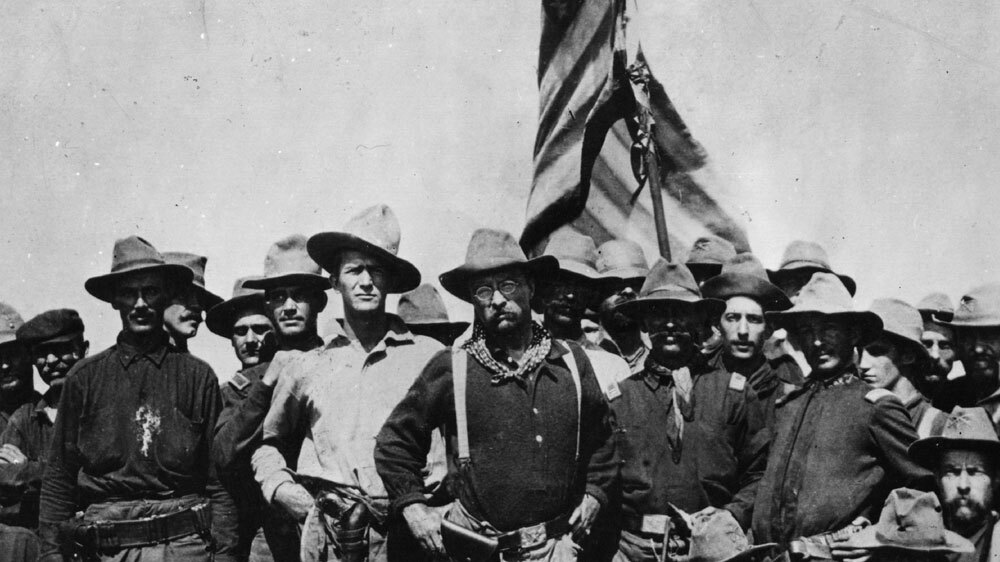

Theodore Roosevelt was nothing if not a renaissance man. In addition to being the 26th president of the United States, Teddy, as he’s affectionately referred to, was also at varying periods of his life a New York state assemblyman, a cowboy in the Dakota territory, the assistant secretary of the Navy, and an author. But many remember him most fondly for his days as leader of the Rough Riders, America’s first volunteer cavalry, composed of Native Americans, Ivy League athletes, Texas Rangers and even glee club singers.
On February 15th, 1898, the USS Maine, a battleship docked outside of Cuba, exploded, killing 262 sailors on board. At the time, Cuba was occupied by Spain, and after an uprising in Havana earlier in the year, the battleship was dispatched to protect American interests on the island. Though Spain denied any involvement in the explosion, the media and a tidal wave of public opinion had already decided who to blame. This was the spark that caused the U.S. to declare war on Spain, and it proved all Theodore Roosevelt needed to hear to quit his job and go where the action was.
Teddy Roosevelt was a major proponent of Cuban independence, and he was already a prominent figure in the U.S. military when the United States declared war. When the USS Maine exploded, Roosevelt quit his job as assistant secretary of the Navy and convinced the secretary of war to let him form his own volunteer regiment. Roosevelt may have been gung-ho, but he knew enough to know where his skills were outmatched. He asked Leonard Wood to be the colonel of this regiment and Roosevelt would serve as a lieutenant colonel.
Word of the volunteer regiment spread and soon Roosevelt and Wood were sifting through 23,000 applications to join. The original plan was to look for outdoorsmen and frontiersmen among the New Mexico and Arizona Territory. But Roosevelt’s fame brought all comers. Volunteers from all over applied to sign up and the group that was accepted was just as eclectic. The first volunteer cavalry of the U.S. was made up of businessmen, ranchers, college students, Native Americans, and many more. Because of their flamboyant, ragtag nature, they were nicknamed the Rough Riders.
Though not originally intended to immediately be sent to the front lines, the Rough Riders proved themselves to be extremely competent soldiers during training in San Antonio. On May 29, 1898, the Rough Riders left Texas for Tampa, where they boarded a ship to Cuba. Unfortunately, due to limited capacity, only three-quarters of the Rough Riders and even fewer horses made it on board.
Within a day of disembarking in Cuba, the Rough Riders were sent into contact with the Spanish. This was the first combat the Rough Riders experienced during the Spanish-American War. Even though the Spanish had a good sense of the trails and topography in the area, the Rough Riders, along with several other brigades, drove them back from their positions and eventually forced them to flee. Though they suffered 7 casualties and 43 injuries, the Battle of Las Guasimas was an unequivocal victory for the Rough Riders. Following this battle, due to sickness in the upper ranks, Col. Wood was promoted, making Theodore Roosevelt the official leader of the regiment. It would be Roosevelt’s next battle that would solidify the Rough Riders as heroes in American history.
Roosevelt and his brigade were sent to San Juan Heights to engage the Spanish atop the hill, keeping them distracted while they were fired upon by artillery. However, Roosevelt found that they were sitting ducks, unable to keep up with the rapid reload of the Spanish gunfire. In true Teddy fashion, Roosevelt whipped his troops into a frenzy and charged up the hill. The enthusiasm spread and soon other brigades were charging up alongside. Before long, the Americans took the hill and pushed back the Spanish.
The Rough Riders saw their last battle during the Siege of Santiago, where they helped secure a border around the city. On August 14, Teddy Roosevelt and the Rough Riders returned to the United States, landing in Montauk, New York. They were made to quarantine for a month due to the malaria, yellow fever, and other diseases that many had brought back with them from Cuba.
A month later, the Rough Riders officially disbanded and handed in all their weapons and supplies to the military. Though they only fought three battles during a ten-week war, the legacy of bravery, audaciousness, and eccentricity of Theodore Roosevelt’s Rough Riders lives on to this day. With wicked enthusiasm, the Rough Riders powered through hard-fought battles and earned their namesake.
If this wasn’t enough motivational history for you, Fox Nation has you covered with their new series, What made America great. For a limited time military members and veterans can click here to get a free one year subscription and enjoy all of their amazing programming absolutely free.
This article is sponsored by Fox Nation.